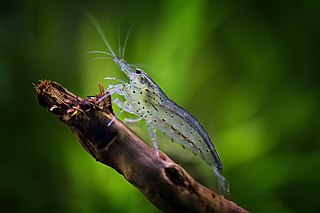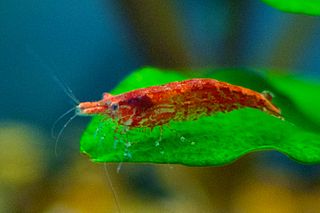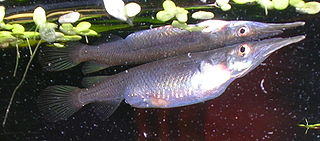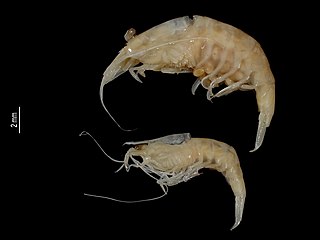
Caridina multidentata is a species of shrimp in the family Atyidae. It is native to Japan and Taiwan. Its common names include Yamato shrimp, Japanese shrimp, Amano shrimp, and algae shrimp.

Caridina is a genus of freshwater atyid shrimp. They are widely found in tropical or subtropical water in Asia, Oceania and Africa. They are filter-feeders and omnivorous scavengers. They range from 0.9 to 9.8 mm to 1.2–7.4 mm in carapace length.

The pygmy gourami, also known as the sparkling gourami, is a freshwater species of gourami native to Southeast Asia.

Syncaris pacifica is an endangered species of freshwater shrimp in the family Atyidae that occurs only in a limited range within the northern San Francisco Bay Area, California, USA. Specifically, this species occurs only in 17 stream segments within Sonoma, Napa and Marin Counties. This species is often translucent to transparent, with both sexes capable of considerable coloration altering, as a sophisticated form of camouflage. This decapod is commonly known as California freshwater shrimp, and is the only extant decapod shrimp in California that occurs in non-saline waters.

Neocaridina davidi is a freshwater shrimp originating from eastern China and northern Taiwan and introduced in the rest of Taiwan, Japan, and Hawaii, which is commonly kept in aquaria. The natural coloration of the shrimp is green-brown. There are a wide range of colors including red, yellow, orange, green, blue, violet, black, etc.; however, the red morph is more frequently sold. The density of coloration on adult shrimp, dependent on breeding, determines their sale price and "quality" (grading). This "quality" is purely aesthetic, as the size, behavior and other characteristics of the animal are more or less equal across varieties. Full-grown shrimp reach about 4 centimetres (1.6 in) long. They prefer clean water, with a pH of 6.5-8, and a temperature of 14–29 °C (57–84 °F) They are most comfortable at 22 °C (72 °F). N. davidi shrimp are omnivores that may live 1–2 years. These shrimps have previously been classified as Neocaridina heteropoda and Neocaridina denticulata sinensis, however are now known as Neocaridina davidi which is based on the oldest known published description of the species.

The African jewelfish, also known as jewel cichlid or jewelfish, is from the family Cichlidae.

Caridina dennerli is a small species of freshwater shrimp from Sulawesi (Indonesia) that grows up to 2.5 centimetres (1.0 in) in length. It takes its name from the German company Dennerle, which supported the expedition that led to the scientific description of the species. It is popularly known as the 'cardinal shrimp' in the aquarium trade.

Caridina thambipillai is a species of freshwater shrimp in the family Atyidae. It is native to Malaysia and Myanmar, where it occurs in streams. It is a common crustacean of the freshwater aquarium trade, where it is known as the Sunkist shrimp.

Neocaridina zhangjiajiensis, known as the pearl shrimp in the aquarium hobby, is a freshwater shrimp. Multiple breeds were bred in Germany for the aquarium trade.

Zenarchopteridae, the viviparous halfbeaks, is a family in the order Beloniformes. The Zenarchopteridae exhibit strong sexual dimorphism, practicing internal fertilisation, and in some cases ovoviviparous or viviparous. The members in the family are mainly found in fresh and brackish water of tropical Asia and New Guinea, but the genus Zenarchopterus also includes marine species from the Indo-Pacific. Several, such as the wrestling halfbeak, have become commonly traded aquarium fish.

The bee shrimp, is a species of small freshwater shrimp in the family Atyidae. It is native to Taiwan. These shrimp are scavengers, and eat small pieces of decayed vegetation and algae. Bee shrimp have a life span of about 18 months. They enjoy a temperature in the 70 to 78 °F range. Many modern versions of bee shrimp are selectively bred for their characteristics.

Caridina spongicola is a small species of freshwater shrimp from Sulawesi (Indonesia) that reaches 0.64 to 1.27 cm in length. In the wild it strictly lives on an undescribed species of freshwater sponge, making it one of only two known commensal species of freshwater shrimp. It is popularly known as the harlequin shrimp, and also sometimes Celebes beauty shrimp or sponge shrimp in the aquarium trade. It is often confused with Caridina woltereckae, a larger and more contrastingly colored species found in the same region as C. spongicola.

Caridina woltereckae, or Sulawesi harlequin shrimp as it is commonly known in the aquarium hobby, is a freshwater shrimp from Sulawesi, Indonesia. It is endemic to Lake Towuti. It resembles the smaller and less contrastingly coloured Caridina spongicola, which is endemic to the same lake.
Caridina ensifera is a freshwater shrimp from Sulawesi. It is one of the 11 species of Caridina endemic to Lake Poso. It lives on a variety of substrates, including wood, rocks, sand and macrophytes, but is also found in pelagic swarms. It is suspected to only live in shallow water.

Caridina caerulea is a freshwater shrimp from Sulawesi. It is one of 11 species in the genus Caridina that is endemic to Lake Poso. It lives on a variety of substrates, including wood, rocks, sand and macrophytes. It is suspected only to live in shallow water.

Caridina linduensis is a species of freshwater shrimp in the family Atyidae, endemic to Lake Lindu and its effluent stream in Sulawesi. It was known only from the type series, collected in 1904, and was recorded again in 2011 in a survey around Lake Lindu and is found in shallow littoral habitats of leaf litter, macrophytes, and dead wood. In the effluent stream it is found on soft substrates and slow flowing water, and is less common in the lake itself. The type locality of Lake Lindu was designated as a Recreation Park in 1978, and is part of the larger Lore Lindu National Park and UNESCO Biosphere Reserve. It is listed under IUCN criterion B1ab(iii,v) as Critically Endangered due to threats from introduced species of fish, land conversion to agriculture, logging, and shore disturbance caused by the grazing of water buffalo. Surveys are required to find the full distribution of C. linduensis, primarily its habitat in the effluent stream. C. linduensis is also sympatric with the recently described species Caridina dali and Caridina kaili.

Feeder shrimp, ghost shrimp, glass shrimp, grass shrimp, river shrimp or feeder prawns are generic names applied to inexpensive small, typically with a length of 1 to 3 cm, semi-transparent crustaceans commonly sold and fed as live prey to larger more aggressive fishes kept in aquariums.

Caridina typus, also known as the Australian Amano Shrimp, is a species of amphidromous atyid shrimp. It was first described by H. Milne-Edwards in 1837. It has a broad distribution in tropical freshwater habitats in the Indo-West Pacific region, with its western range extending to eastern Africa and its eastern range extending to Polynesia. It is commonly found in rivers and streams in coastal areas or on islands. C. typus is known to play a role in sediment distribution and shredding leaf litter, manipulating the environment using their pereiopods and setaceous chelae. The species is also an important component of the food web, both as scavengers and as prey items, and is considered a keystone species for the stream ecosystems it inhabits. According to Choy and Marshall, the species can be characterized by a "short, dorsally unarmed rostrum, the presence of epipods on the first four pairs of pereiopods, and the presence of an appendix interna on the endopod of the first pleopod of both sexes." It can be kept in captivity by aquarists as pets.

Caridina sarasinorum is a species of freshwater atyid shrimp. It is one of eight Caridina species endemic to Lake Poso.



















